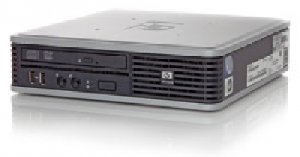HP DC7900 USDT Ultra slim Desktop
Compact form factor. Energy efficient. DisplayPort. Easy to swap out components. Tool-less. 2.6 by 10 by 10 inches. Uses notebook-class hard drives and optical drive. Uses only 31 watts of power while idling, and 63W while loaded.
Power Supply
The Power Supply is an external brick style AC adapter. It uses the HP Smart Pin style plug. Be careful if not using an HP OEM replacement or original PSU. Some of the aftermarket units will not work without modification.
- AC adapter, 135W
- HP PN: 482133-001
The OEM PSU is compatible with HP Compaq Business Desktop Dc7900
Computer Setup (F10) Utility Guide
The latest BIOS for this computer is version 1.27, the flash file is 7G1_0127.bin contained within SP73584.exe. The folks at HP are not kind or smart enough to provide the .bin file for direct download. You will have to download the Windows executable and run it under WINE. It will extract successfully using WINE and create a folder in: ~/.wine/drive_c/swsetup under the default configuraiton. Look in the SP73584/DOS Flash subfolders to obtain 7G1_0127.bin, copy to a FAT32 formatted flash drive and use the BIOS update utility within the BIOS to read the bin file.
Use Computer Setup (F10) Utility to do the following:
● Change factory default settings.
● Set the system date and time.
● Set, view, change, or verify the system configuration, including settings for processor, graphics,
memory, audio, storage, communications, and input devices.
● Modify the boot order of bootable devices such as hard drives, diskette drives, optical drives, or
USB flash media devices.
● Enable Quick Boot, which is faster than Full Boot but does not run all of the diagnostic tests run
during a Full Boot. You can set the system to:
❑ always Quick Boot (default);
❑ periodically Full Boot (from every 1 to 30 days); or
❑ always Full Boot.
● ● Establish an Ownership Tag, the text of which is displayed each time the system is turned on or
restarted.
● Enter the Asset Tag or property identification number assigned by the company to this computer.
● Enable the power-on password prompt during system restarts (warm boots) as well as during
power-on.
● Establish a setup password that controls access to the Computer Setup (F10) Utility and the
settings described in this section.
● Secure integrated I/O functionality, including the serial, USB, or parallel ports, audio, or embedded
NIC, so that they cannot be used until they are unsecured.
● Enable or disable removable media boot ability.
● ENWW
Select Post Messages Enabled or Disabled to change the display status of Power-On Self-Test
(POST) messages. Post Messages Disabled suppresses most POST messages, such as memory
count, product name, and other non-error text messages. If a POST error occurs, the error is
displayed regardless of the mode selected. To manually switch to Post Messages Enabled during
POST, press any key (except F1 through F12).
Enable or disable legacy diskette write ability (when supported by hardware).
Computer Setup (F10) Utilities
1
● Solve system configuration errors detected but not automatically fixed during the Power-On Self-
Test (POST).
● Replicate the system setup by saving system configuration information on diskette and restoring
it on one or more computers.
● Execute self-tests on a specified ATA hard drive (when supported by drive).
● Enable or disable DriveLock security (when supported by drive).
Computer Setup can be accessed only by turning the computer on or restarting the system. To access the Computer Setup Utilities menu, complete the following steps:
- Turn on or restart the computer. If you are in Microsoft Windows, click Start > Shut Down > Restart.
- As soon as the computer is turned on, press F10 when the monitor light turns green to enter Computer Setup. Press Enter to bypass the title screen, if necessary. NOTE: If you do not press F10 at the appropriate time, you must restart the computer and again press F10 when the monitor light turns green to access the utility.
- Select your language from the list and press Enter.
- A choice of five headings appears in the Computer Setup Utilities menu: File, Storage, Security, Power, and Advanced.
- Use the arrow (left and right) keys to select the appropriate heading. Use the arrow (up and down) keys to select the option you want, then press Enter. To return to the Computer Setup Utilities menu, press Esc.
- To apply and save changes, select File > Save Changes and Exit.
● If you have made changes that you do not want applied, select Ignore Changes and Exit. ● To reset to factory settings or previously saved default settings (some models), select Apply Defaults and Exit. This option will restore the original factory system defaults.
Troubleshooting
Unable to boot from USB Flash Media
This is a known issue with this model, and there is a confirmed fix. Advise available doing an online search yields no favorable results, you can only find the correct solution here!
- Update BIOS to latest version 1.2.7, this is discussed in a previous section of this page.
- The BIOS menu layout is moronic. There is a couple common settings that trip people up and prevent USB boot. Make sure you check these bios settings:
